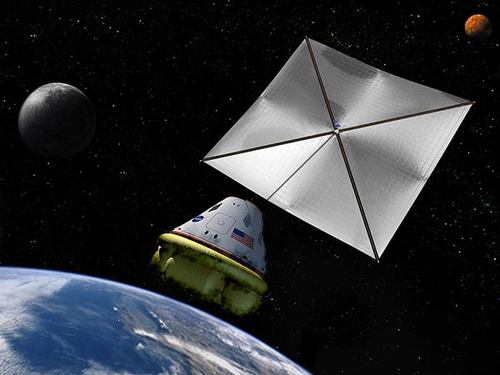Solar Powered Spaceship
 The sun puts out roughly
4
×
1
0
2
6
Watts of electromagnetic energy. The sun emits as a blackbody at roughly 6000 K. The peak wavelength of the solar emission, i.e. the wavelength at which the intensity is highest, is approximately 500 nm (which is green). For the purposes of this discussion, let's assume
all
of the sun's radiation comes out at this wavelength. If we think about the radiation as photons, each photon carries a momentum given by
p
=
h
/
λ
and an energy
E
=
h
c
/
λ
by quantum mechanics.
The sun puts out roughly
4
×
1
0
2
6
Watts of electromagnetic energy. The sun emits as a blackbody at roughly 6000 K. The peak wavelength of the solar emission, i.e. the wavelength at which the intensity is highest, is approximately 500 nm (which is green). For the purposes of this discussion, let's assume
all
of the sun's radiation comes out at this wavelength. If we think about the radiation as photons, each photon carries a momentum given by
p
=
h
/
λ
and an energy
E
=
h
c
/
λ
by quantum mechanics.
One can use the electromagnetic radiation to propel spaceships, although it doesn't work all that well even though it is cheap. Consider a spaceship propelled by a "solar sail", a perfectly square reflecting sheet of material 1 km on a side oriented so the normal points directly towards the sun. At the earth's orbit, how much force in Newtons would such a solar sail experience?
Details and Assumptions
- The earth orbits at a distance of roughly 1 . 5 × 1 0 8 km from the sun.
- The speed of light is 3 × 1 0 8 m/s.
- Planck's constant is h = 6 . 6 3 × 1 0 − 3 4 kg ⋅ m 2 /s .
The answer is 9.43.
This section requires Javascript.
You are seeing this because something didn't load right. We suggest you, (a) try
refreshing the page, (b) enabling javascript if it is disabled on your browser and,
finally, (c)
loading the
non-javascript version of this page
. We're sorry about the hassle.
3 solutions
excellent solution ..
Notice that the particle absorbs the radiation, then reflecting it back. Thus the change in momentum is Δ p = c 2 Δ U . Since the change in energy is equal P Δ t , where P is the power of the sun, we get Δ U = A I Δ t , where A and I denote area of the sail and the intensity of the sun. We know F Δ t = Δ p , consequently, F = c 2 A I .
The solar power per unit area when it reach Earth and the solar sail:
Δ P s = 4 π R 2 P s = 4 π ( 1 . 5 × 1 0 1 1 ) 2 4 × 1 0 2 6 = 1 4 1 4 . 7 1 0 6 0 5 W / m 2
The radiation power collected by the 1-km square solar sail:
P s a i l = Δ P s A = 1 4 1 4 . 7 1 0 6 0 5 × 1 0 6 = 1 4 1 4 7 1 0 6 0 5 W
Since all the radiation power is converted to mechanical power and that E = λ h c = c p ⇒ momentum p = c E , then the force:
F = d t d p = 2 × c P s a i l = 2 × 3 0 0 0 0 0 0 0 0 1 4 1 4 7 1 0 6 0 5 = 9 . 4 3 N
Firstly,
Let us calculate the power that is received by the sheet at that distance.
P r e c e i v e d = 4 π d 2 P s u n ⋅ Area of the sheet
Thus,
P r e c e i v e d = 4 π ( 1 . 5 × 1 0 1 1 ) 2 4 × 1 0 2 6 ( 1 0 3 ) 2 = 1 , 4 1 4 , 7 1 0 , 6 0 5 Watts
Now,
Since the Power is received in the form of photons ,
P r e c e i v e d = η × Energy of each Photon ,
where η represents the number of photons received by the sheet per unit time
Therefore,
η ⋅ λ h c = 1 , 4 1 4 , 7 1 0 , 6 0 5
Also, note that the Change in Momentum of each photon as it reflects off the sheet is 2 p
Hence,
Force = d t d p t o t a l = η × 2 p = η × λ 2 h
⇒ Force = 1 , 4 1 4 , 7 1 0 , 6 0 5 × h c λ × λ 2 h
⇒ Force = 3 × 1 0 8 1 , 4 1 4 , 7 1 0 , 6 0 5 × 2 ≈ 9 . 4 3 N